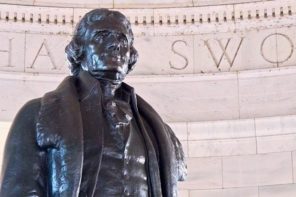My previous post on corporate personhood ended by asking for a principled reason why we should protect the “religious freedom” of religiously-affiliated nonprofit corporations such as Wheaton College but not for-profit corporations such as Hobby Lobby and Conestoga Wood.
In her essay at The Immanent Frame, “The Impossibility of Religious Freedom,” Winnifred Fallers Sullivan puts this question more bracingly:
Why should churches and religious orders be obviously and unproblematically exempt, particularly in the aftermath of a series of sexual and financial scandals, while Hobby Lobby is not? Why disdain the representations of the Greens and the Hahns that they consider their businesses to be a religious ministry? Where is it written in the Constitution that only the religious practices of churches or church-related non-profits are entitled to accommodation?
Justice Ginsburg has a response to the professor’s questions. Religious organizations, she argues in her Hobby Lobby dissent, “exist to foster the interests of persons subscribing to the same religious faith,” whereas for-profit corporations do not.
Workers who sustain the operations of those corporations commonly are not drawn from one religious community. Indeed, by law, no religion-based criterion can restrict the workforce of for-profit corporations. . . . The distinction between a community made up of believers in the same religion and one embracing persons of diverse beliefs, as clear as it is, constantly escapes the Court’s attention.
“It is not clear to whom she refers here,” Sullivan remarks on this passage. “As with the other justices in this case and others, her Delphic pronouncements about religion seem to come from the ether. How does she know this? Few who study religion would agree with this statement.”
One of the merits of Sullivan’s work is that it goes “beyond the culture-wars framing of most commentaries” to interrogate assumptions about religion and the law shared by conservatives and liberals. Here she draws on decades of study of the phenomenology of American religion as shaped by and as shaping the modern rule of law. Above all, this study has attended to the heterogeneity of religious communities and the agency of individual practitioners.
Indeed, Americans have always been incredibly varied, creative, and entrepreneurial in living out what they take to be their religious obligations—religious obligations that range far beyond the prescriptions of the mainline churches, which seem staid, contained, and tamed to the many who consider their own religious practices, unapproved by traditional religious authorities, to be alive with the spirit. They find their religious community and their religious fields of action in places other than churches—including the marketplace.
On Sullivan’s view, the Hobby Lobby dissenters and their allies—while careful not to appear to pass judgment on the sincerity of the plaintiffs’ beliefs—cannot but pass judgment on their quality: “Real Christians, the dissenters and their supporters say, do not mix religion with business. Nor do real Christians seek to disadvantage others in the exercise of their religious freedom.” Protection of religious freedom, Sullivan contends, means “protection only for the kind of religion they like, the private, individualized, progressive kind.”
Oracular or not, Ginsburg is making two distinct claims. One is that the workforce of religious nonprofits is significantly homogeneous as compared to the workforce of for-profits. This claim surely is empirically questionable, especially as is applies to large, religiously-affiliated nonprofits with massive staffs and commercial interests. Consider Catholic hospitals, which operate 15 percent of all hospital beds in the country and employ around 725,000 people, both Catholic and non-Catholic. How spiritually uniform can 725,000 people be?
Ginburg’s other claim is about the legal purposes of for-profits as compared to the purposes of religious nonprofits. This clearly emerges when she later quotes Gilardi v. US Department of Health and Human Services, “for-profit corporations are different from religious non-profits in that they use labor to make a profit, rather than to perpetuate [the] religious value[s] [shared by a community of believers].”
But Sullivan is not interested in entering into the esoterica of corporate law. Her concern is “the rotten core at the heart of all religious freedom laws,” the “multiple legal fictions at the heart of any legal protection for religious freedom—legal fictions whose value is exhausted.” Legal fictions are necessary, Sullivan writes. But stretched too far, they can become “nothing more than lies.” Her project is a far more foundational challenge, a challenge to the very idea of “Religion” as a category under the law.
RD contributing editor Austin Dacey will be writing a series of posts in the coming months as part of a joint project between The Immanent Frame and Religion Dispatches made possible by the generosity of the Luce Foundation.




